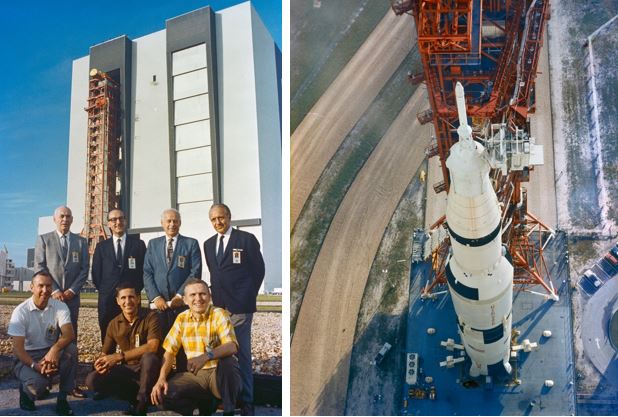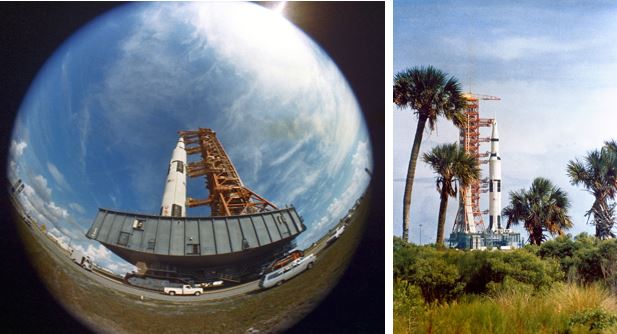On October 9, 1968, the first Saturn V Moon rocket to carry astronauts into space rolled out from the Kennedy Space Center’s (KSC) Vehicle Assembly Building (VAB) to Launch Complex 39A. On hand to watch the historic event were the three astronauts scheduled to ride that rocket into space, Apollo 8 crewmembers Frank Borman, James A. Lovell and William A. Anders. Senior NASA managers at KSC for the launch of the first crewed Apollo mission, Apollo 7, planned for two days later, also observed the Apollo 8 rollout.

Kneeling, left to right: James Lovell, William Anders, and Frank Borman; standing, left to right: Manned Spacecraft
Center Director Robert Gilruth, NASA Associate Administrator for Human Space Flight Robert Mueller, Marshall
Space Flight Center Deputy Director Eberhard Rees, and Kennedy Space Center Director Kurt Debus. Right: View of
the Saturn V rollout from atop the VAB.
The rollout took about six hours to cover the three and one half miles from the VAB to the launch pad. The Mobile Transporter, an 8-tracked vehicle, carried the Mobile Launch Platform, Launch Umbilical Tower, and the Saturn V rocket itself, a total of 12.6 million pounds, at a top speed of 0.85 miles per hour. Once at the pad, engineers over the next several weeks thoroughly tested the rocket and spacecraft prior to the late December launch.
The road to arrive at the rollout of the Apollo 8 vehicle was a lengthy and somewhat complicated one. Assembly of the Apollo 8 Saturn V began with the arrival of the first stage at KSC in late December 1967, just 6 weeks after Apollo 4, the first uncrewed Saturn V mission. The second and third stages were stacked early in 1968, but after the Pogo oscillation problems encountered during the April Apollo 6 mission, they were de-stacked so the second stage could be modified to avoid a recurrence of the issue. Once the repairs were completed, the stages were stacked again in July and August. The Command and Service Modules (CSM) arrived in August and engineers put them through a series of tests before transferring them to the VAB for assembly with the rocket just two days before the rollout to the pad.
The plans for the Apollo 8 mission profile also changed during this time. In late 1967, NASA designed it to be the third uncrewed test flight of the Moon rocket, but decided in April 1968 to have it be the first Saturn V to carry a crew. Their mission would be to test the Lunar Module (LM) along with the CSM in an Earth orbital flight. Preparations for the LM ran behind schedule, and in August NASA deleted that component from the mission and began to consider other options, including a lunar orbital flight. A final decision on a lunar mission was contingent upon Apollo 7 being successful. Deletion of the LM from the flight also led to a change of the crew who would fly Apollo 8.



























